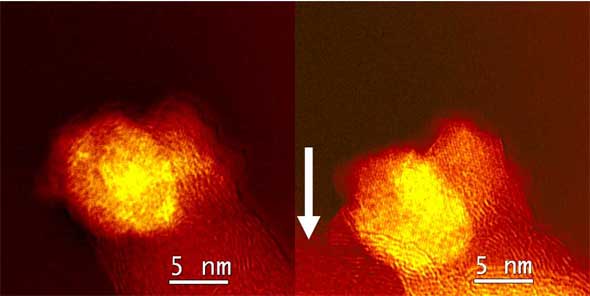| Posted: August 25, 2006 |
Reversed growth reveals secrets of carbon nanotubes |
|
(Nanowerk News) Researchers at the Advanced Technology Institute, University of Surrey have reversed the growth of carbon nanotubes from catalysts, using electron beam irradiation in an electron microscope. High resolution imaging of this reverse process led to the conclusion that carbon nanotube growth is essentially a surface-driven process.
|
|
Carbon nanotubes – tubes formed from a repeating arrangement of carbon atoms with diameter of the order of a billionth of a meter – have remarkable mechanical, electronic and optical properties. Their potential applications range from ultra-strong ropes to ultra-small transistors, as well as field-emission displays, biosensors and optical switches. Unfortunately it is not yet possible to produce carbon nanotubes on a large scale with controlled properties (such as diameter and chirality – the degree of spiral in the arrangement of the carbon atoms). One important method for producing tubes is to use small particles of a metal such as nickel, which at high temperatures catalyse the decomposition of a carbon-containing gas forming carbon nanotubes which ‘grow’ on each metal particle. This process has not yet been fully understood, but recent work at the University of Surrey sheds new light on the interaction between the catalysts and the carbon atoms involved in the growth.
|
 |
| A carbon nanotube, with its Ni catalyst at the top, shrinks in a controlled manner under electron beam irradiation. After ~7 minutes of irradiation at 75A/cm2, ~60nm length of the carbon nanotube has been consumed and the holey carbon film supporting the tube can be seen (arrow). The measurement of the reversal rate and the high-resolution analysis of the crystalline structure reveal that the growth process of carbon nanotubes from catalysts is a surface-driven process. (Source: University of Surrey)
|
|
“There is still a hot debate about whether carbon nanotubes grow from catalysts as a result of carbon diffusing through or on the surface of the catalyst”, said Dr Vlad Stolojan, who led the research team. “This is mainly because the result of the growth process can only be observed at room temperature, after the process is completed. Through analysing the physics behind the controlled growth reversal that we observed, we concluded that the steady-state part of the growth process is surface-driven and demonstrated that the carbon nearest to the catalyst’s surface is highly mobile”.
|
|
Stolojan and his co-workers studied the reversal process with high spatial resolution, in a transmission electron microscope, and have shown that the catalyst remains attached to the nanotube throughout the irradiation sequence, whilst an equivalent of 1 carbon atom is consumed per every nickel atom in the catalyst. By considering the effects of heating and irradiation, they have discovered that the carbon atoms at the catalyst surface are very easily removed (also confirmed by theoretical simulations), followed by a rapid rearrangement of the nanotube’s atoms around the catalyst. They have also discovered that changes in the nanotube’s growth direction are linked to a sudden rotation of the catalyst.
|
|
The observed controlled growth reversal under the high-energy electron irradiation will allow for controlling the height of individual nanotubes within patterned arrays, thus offering three-dimensional control of nanotube arrays for field-emission applications.
|
|
“The ability to observe the behaviour of the catalyst during the growth-reversal of the nanotube is exciting, as it allows the reverse-engineering of the steady-state growth process. Ultimately, this can help establish the relationship between the catalyst’s crystalline structure and the chirality of the resulting nanotube; the control of the chirality being the true ‘holy grail’ of carbon nanotube growers.” said Prof Ravi Silva, the Director of the Advanced Technology Institute, University of Surrey from the UK.
|
|
The findings were published in a paper titled "Controlled Growth-Reversal of Catalytic Carbon Nanotubes under Electron-Beam Irradiation".
|

